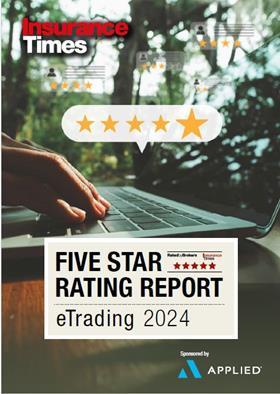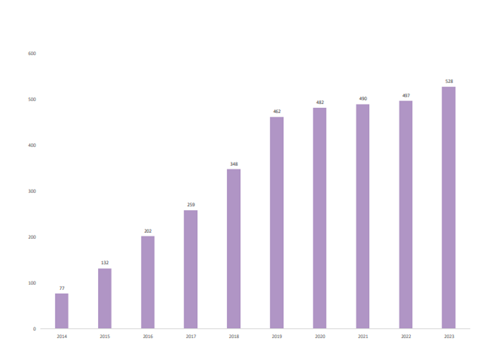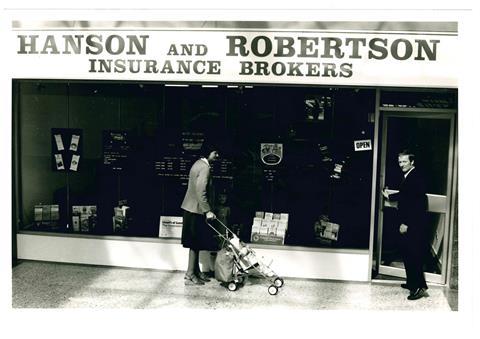’To me, eTrading is like water running through pipes – it’s a facilitator. Any modern insurer or broker now just expects it to be there,’ says managing director
In May 2024, Insurance Times released its 10th annual Five Star Rating Report: eTrading research, sponsored by Applied Systems. However, the birth of this technology goes back even further than a decade.

In insurance, digital or electronic trading (eTrading) refers to the process of information being exchanged digitally between brokers and insurers in order to arrange and secure cover for customers.
One of the very first eTraded policies was in private motor insurance. This can be traced back to Hanson and Robertson Insurance Brokers (H&R) in 1995 – an independent Aberdeen-based broker established in 1972 by Hugh Robertson, who is now retired.
His daughter, Shona Robertson, partner of H&R, now runs the family business.
Speaking exclusively to Insurance Times about her father pioneering the switch to digitally traded policies, she said: “When insurers came in to audit him, what the insurer had on file compared to what we had in our cover book didn’t really match up or details were missing because we were writing all these cover notes manually.”
A cover note is a temporary document issued by an insurance company, which acts as proof of insurance until a final policy can be issued. These are typically all gathered together in a cover book.
Robertson’s father proposed the idea of this process becoming more digital. On the back of this suggestion, the broker then switched to a laser proposal form and cover certificate, where information could be entered via a computer and then printed.
“Nothing electronic happened at this point – he would take the laser cover notes and batch post them to [the insurer, which] would then put the information onto [its] system. But it was around 1995 when we started to pass information electronically to insurers,” Robertson explained.
She recalled her father speaking at a conference around this time about insurance players of the future trading digitally and the role of the broker changing – and this idea was not received well.
Fast forward to 2000 and H&R launched what was one of the market’s first quote and bind websites for brokers – a private car quote and bind facility that operated online.
H&R was also one of the first brokers to pilot CDL’s policy document system in July 2004.
“He was very much a pioneer,” Robertson added.
Tipping point
Today, eTrading is very much the norm.
Read: Applied secures record commercial lines eTrading growth
Read: How Zurich improved eTrading for brokers with enhanced communication
Explore more eTrading-related content here or discover other news analysis stories here
For Vivek Banga, managing director of Polaris UK, his highlight over the last decade was around “how mainstream eTrading had become”.
He said: ”To me, eTrading is like water running through pipes – it’s a facilitator. Any modern insurer or broker now just expects it to just be there.”
He explained that in the early 2000s, brokers almost needed to be convinced about using eTrading, insurer extranets or software houses.
However, according to Banga, the tipping point came between 2010 and 2012 when “the scepticism died out”.
He explained: “There was this realisation that the more we automate, the more efficient the business. Personal lines broking came under pressure because of the emergence of direct players – that led to electronic data technology being developed [and] greater automation.
“Commercial lines faced less competitive pressure to automate. There was also this perception that [these products] would be hard to automate.”
Banga recalled that in 2014, Polaris’ digital trading platform – called Imarket – transacted less than 100,000 policies. In 2023, however, it transacted more than 528,000 policies.
He continued: “That shows what a good trajectory it has been. It is safe to assume that [eTrading] has continued to grow year-on-year – the product range [available via eTrading] has expanded, as well as product complexity increasing.”

In July 2016, the London market’s eTrading platform – called Placing Platform Limited (PPL) – first went live. By March 2023, an updated version of the platform was launched, called PPL Next Gen. This included 100 changes and fixed a number of defects raised by market participants.
Banga added: “The boundaries of what can be traded online has continued to increase. Technology is no longer as expensive as it used to be. The market has moved from disruption to collaboration.”
Savan Shah, head of research at Insurance Times and author of its annual eTrading reports, noted that eTrading has “opened doors for brokers, helping them find better insurance options”.

Future of eTrading
But what does the future hold for eTrading?
“What has helped in eTrading complex risk is that you can provide manual intervention where needed, Banga said.
”Growth will continue in commercial lines. With cost pressures on brokers and insurers, both being conscious of profit margins and profitability, people will continue to automate more business.”
However, Banga noted that the industry still has ”a long way to go” in terms of eTrading risks that are more intricate.
He emphasised, however, that eTrading platforms can be used not only for placing risks, but for managing them too, which is useful when reviewing these more complicated risks.
He explained: ”Even for very complex risks, there might be elements of managing that policy that can be offered online. It’s not just the trading of business – it’s also the managing of the policy afterwards.”
Banga tipped broker consolidation as a trend impacting eTrading too. He explained that as brokers grow in size, it makes sense for them to trade particularly large books in a more efficient, digital way.
“The answer is to create centres of excellence to have an eTrading capability to work with insurers,” Banga continued.
Banga predicted a future, therefore, where eTrading will become “more sophisticated” in terms of handling volume, product choice and complexity of risks.
Likewise, Wayne Jefferson, eTrading manager at Applied Systems, predicted that the product footprint within eTrading will expand.
“[ETrading] is a cost effective solution for [the insurer] and broker, but the larger corporate risks will always be manually traded,” Jefferson added.












































No comments yet